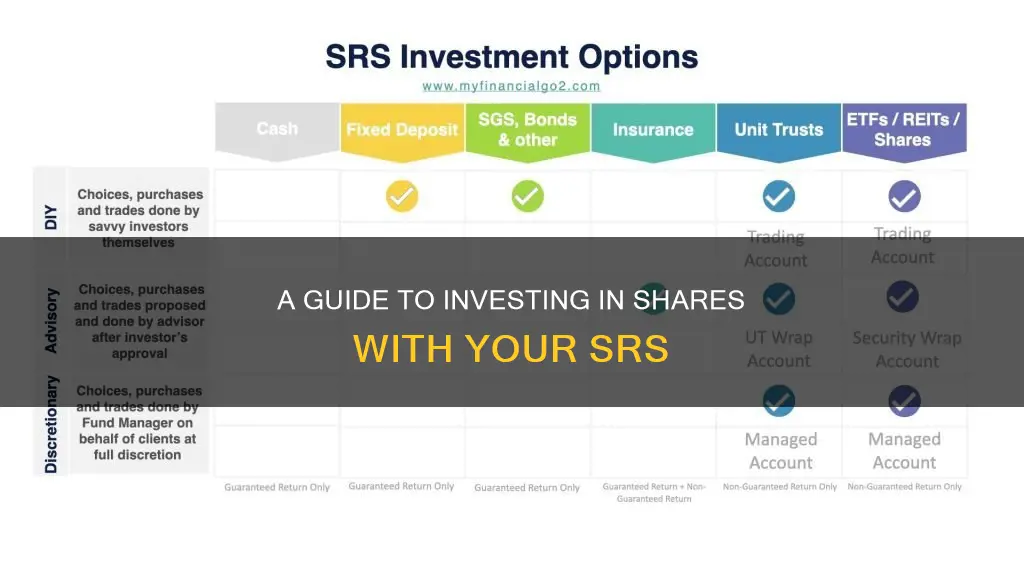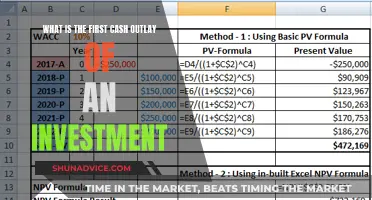
The Supplementary Retirement Scheme (SRS) is a voluntary scheme that helps Singaporeans save for retirement while offering tax relief. The scheme complements the Central Provident Fund (CPF) and allows for flexible retirement savings. Contributions to the SRS account are eligible for dollar-for-dollar tax relief, up to S$15,300 for citizens and permanent residents and S$35,700 for foreigners. This tax benefit is particularly advantageous for mid to high-income earners.
While the SRS scheme provides an opportunity to save on taxes, the funds in the account earn a low interest rate of 0.05% per annum, which is insufficient to keep up with inflation. Therefore, it is essential to invest your SRS funds to boost your retirement savings. There are various investment options available, including unit trusts, stocks, bonds, insurance products, and more.
One popular option is to invest in shares or equities listed on the Singapore Exchange (SGX). This can be done through brokerage platforms, and some popular choices include Blue-Chip stocks and Real Estate Investment Trusts (REITs). However, investing in shares comes with certain complexities, such as corporate actions, and brokerage fees can be high for small investment accounts.
Another option is to invest in Exchange-Traded Funds (ETFs), which are traded on stock exchanges and offer broad diversification across asset classes and sectors. ETFs are cost-effective, liquid, and transparent, making them a popular choice for SRS investors.
Additionally, you can consider investing in Singapore Government Securities (SGS), such as Treasury Bills (T-bills) and SGS bonds, which are considered low-risk due to the government's AAA credit rating.
To maximise the potential of your SRS contributions, it is important to diversify your investments and consider your risk tolerance, investment goals, and time horizon.
| Characteristics | Values |
|---|---|
| Type of Scheme | Supplementary Retirement Scheme (SRS) |
| Purpose | Help citizens, permanent residents (PR) and foreigners build up their retirement nest egg with the added tax incentive |
| Tax Relief | Dollar-for-dollar tax relief of up to $15,300 for citizens and PRs and $35,700 for foreigners |
| Taxable Income Reduction | If taxable income is $55,300, contributing the maximum SRS amount of $15,300 reduces taxes by $1,071 |
| Tax Savings ROI | (1,071/15,300) = 7% |
| Personal Income Tax Relief Cap | $80,000 each year |
| Account Opening | DBS, OCBC, or UOB |
| Interest Rate | 0.05%/annum |
| Maximum Yearly Contribution | $15,300 for Singaporeans and PRs, $35,700 for foreigners |
| Investment Options | SGX-listed stocks, ETFs, REITs, bonds, Singapore Savings Bonds & T-Bills, regular shares savings, robo advisors, unit trusts/mutual funds, insurance products/annuities, fixed deposits |
What You'll Learn

Endowment Insurance Plans
An endowment plan typically requires you to pay a single premium or regular premiums over a specified period. The plan will then accumulate cash value over time, and you will receive a payout upon maturity or when you reach the selected retirement age. The payout can be a lump sum or a stream of income for a fixed number of years.
Types of Endowment Plans
There are different types of endowment plans available, including:
- Wealth Accumulation Plan: This plan allows you to pay a one-time premium, which grows in value over time. It offers both guaranteed and non-guaranteed returns, with the non-guaranteed portion coming from reversionary and terminal bonuses. You have the flexibility to decide when to withdraw the money for retirement, and you can benefit from compound interest.
- Retirement Income Plan: This plan provides regular monthly or yearly income during retirement. You can choose the retirement age and the income stream period. It also offers guaranteed and non-guaranteed returns, with non-guaranteed returns coming from reversionary and terminal bonuses.
- Short-Term Guaranteed Return Plan: This type of plan provides a guaranteed maturity return over a short policy term, usually three years. It is suitable for those with an investment time horizon of less than ten years.
- Investment-Linked Plan (ILP): ILPs allow you to invest in a range of sub-funds or unit trust funds. The returns depend on the performance of the chosen sub-funds, and there is no guaranteed return. ILPs offer more flexibility in terms of investment choices but may have higher fees and restrictions on withdrawals.
Endowment Plans and SRS
You can purchase endowment plans using your SRS funds, but there are some conditions and restrictions imposed by the Ministry of Finance. Here are the key points to note:
- Single Premium Products: Only single premium products are allowed for SRS investment. This means you need to make a one-time lump-sum payment instead of regular premiums.
- Life Cover Limit: The life cover, including total and permanent disability benefits, is capped at three times the single premium amount.
- Contribution Continuation: Plans may include a contribution continuation feature upon disability, allowing you to continue contributing to the plan if you become disabled.
- Excluded Insurance Types: Critical illness, health, and long-term care insurance products are excluded from SRS investment.
- No Trust Nomination: Trust nomination is not permitted for life insurance products purchased with SRS funds.
Advantages of Endowment Plans
Endowment plans offer several benefits, such as:
- Guaranteed Returns: Many endowment plans offer guaranteed returns upon maturity, ensuring that you don't lose your principal investment.
- Retirement Income: Endowment plans provide a steady income stream during retirement, helping you plan for your golden years.
- Flexibility: You can choose the retirement age, income period, and premium payment terms that suit your needs.
- Insurance Coverage: Endowment plans provide basic insurance coverage, protecting you against death and, in some cases, terminal illness.
Disadvantages of Endowment Plans
However, there are also some potential drawbacks to consider:
- Opportunity Costs: If you invest in endowment plans, you may miss out on the potentially higher returns offered by other investments, such as stocks or ETFs.
- Locked-In Periods: Endowment plans typically have locked-in periods, and surrendering the plan early may result in a surrender value lower than the amount you invested.
- Limited Insurance Coverage: The insurance coverage provided by endowment plans is usually low, and they may not be suitable for those seeking comprehensive insurance protection.
Things to Consider
When deciding whether to invest in endowment plans using your SRS funds, here are some factors to consider:
- Investment Horizon: If you have a long investment horizon, you may be better off investing in other instruments that offer potentially higher returns, such as stocks or ETFs.
- Risk Tolerance: Endowment plans are generally considered conservative investments. If you have a higher risk appetite, you may prefer to explore other options.
- Fees and Charges: Compare the fees and charges associated with different endowment plans. Some plans may have high upfront fees or ongoing fees that can eat into your returns.
- Withdrawal Flexibility: Consider your withdrawal needs and preferences. Endowment plans may have restrictions on early withdrawals or penalties for surrendering the plan before maturity.
- Investment Goals: Ensure that the endowment plan aligns with your overall investment goals and retirement planning strategy.
In conclusion, endowment insurance plans can be a viable option for those seeking a combination of insurance coverage and steady returns for retirement planning. However, it's important to carefully consider the features, restrictions, and potential drawbacks of these plans before investing your SRS funds.
Distribution as an Investment: Cash Flow Statement Insights
You may want to see also

Unit Trusts
How Unit Trusts Work
When you invest in a unit trust, you become a unit holder, giving you rights to the trust's assets. The fund manager purchases securities, such as stocks or bonds, on the stock market, and the fund is divided into units that investors buy. The value of the trust's assets is determined by the number of units issued multiplied by the price per unit, minus transaction and management fees.
Advantages of Unit Trusts
- Diversification: They provide investors with an opportunity to invest in a diversified portfolio of stocks, bonds, or other assets, which would be more difficult and costly to achieve by purchasing individual securities.
- Professional Management: Unit trusts are managed by financial professionals who conduct research, selection, and portfolio adjustments, making it more convenient for investors who may not have the time or expertise to manage their investments actively.
- Flexibility: There is no lock-in period, so investors can cash out at any time to explore other investment opportunities. Additionally, unit trusts cater to investors with different affordability levels, allowing for lump-sum or monthly investments.
- Regulation and Transparency: Unit trusts are regulated and required to publish information on past performance, fees, and securities held, providing transparency to investors.
Disadvantages and Risks of Unit Trusts
However, there are also some potential drawbacks and risks associated with unit trusts:
- Fees: Unit trusts may charge various fees, including front-load, entry fees, and distribution fees. These fees can reduce investment returns over time.
- Performance Dependence on Fund Manager: The success of the trust relies on the fund manager's expertise and decisions.
- No Principal Investment Guarantee: Investing in unit trusts carries the risk of losing money, as the principal investment is not guaranteed. The unit value or income may decrease due to changing market conditions or other factors.
- Liquidity: While unit trusts offer relatively quick withdrawal options, they are generally less liquid than other pooled investment products traded on exchanges, such as exchange-traded funds (ETFs).
When considering unit trusts as an investment vehicle, it is essential to assess your risk tolerance, investment objectives, and financial situation. Unit trusts provide an opportunity for diversification and professional management but come with fees and the risk of losing a portion or all of your investment.
Warren Buffet's Berkshire Cash Reserves: Where Does it Go?
You may want to see also

Stocks or ETFs
Stocks and ETFs are two very different investment vehicles, each with its own set of advantages and disadvantages. When it comes to investing your Supplementary Retirement Scheme (SRS) funds, it's important to understand the differences between the two before making a decision.
If you're considering investing in stocks using your SRS funds, it's important to note that you can invest in stocks listed on the Singapore Exchange (SGX). This can be done through your existing brokerage firm rather than through the banks administering your SRS account. There is a wide range of stocks available for purchase using SRS funds, but it's always good to check with your SRS agent bank to confirm. Keep in mind that small and micro-cap stocks that are highly speculative are likely excluded from this list.
One of the main challenges of purchasing stocks using your SRS account is the brokerage commission cost involved. Standard local brokerage houses typically charge a minimum commission amount of $25 or a fixed rate of approximately 0.28%. Popular low-cost brokerage firms such as Tiger Brokers, Moomoo, Interactive Brokers, and Saxo Capital do not allow purchases using an SRS account, which can be a problem for investors who wish to invest smaller amounts using a dollar-cost averaging approach. FSMOne offers a minimum commission cost of $8.80, making it a more affordable option for those investing smaller amounts.
Instead of buying individual stocks, you can also invest in a basket of pre-selected stocks offered by brokerage firms, such as the OCBC Blue Chip Investment Plan. This allows you to invest in a diverse range of stocks while benefiting from tax savings.
On the other hand, investing in Exchange-Traded Funds (ETFs) is one of the easiest ways to gain exposure to a broad array of stocks. ETFs can be index funds, country-specific funds, or sector-specific funds, such as the real estate sector. Unlike the CPF Investment Scheme, which has only four approved ETFs, there are no restrictions on using SRS funds to purchase ETFs listed on the SGX.
Some popular ETFs among local investors include the SPDR STI ETF, which provides exposure to the top 30 largest SG stocks, and the ABF Singapore Bond Index Fund, which offers exposure to high-quality bonds issued by Singapore corporates. The Lion-Phillip S-REIT ETF is another popular choice for those seeking exposure to REITs. For those looking for foreign exposure, the Xtrackers MSCI China UCITS ETF and the Lion-OCBC Securities Hang Seng Tech ETF offer access to the Chinese and Hong Kong markets, respectively.
When investing in ETFs using your SRS account, it's important to consider the lack of variety in ETF choices, as you are mostly limited to those listed on the SGX. Additionally, there may not be a cheap solution for purchasing ETFs monthly with a small investment outlay. However, investing in ETFs is generally considered a more diversified and safer option compared to purchasing individual equities.
In summary, both stocks and ETFs have their advantages and disadvantages. Investing in stocks may offer more flexibility and control over your investments, while ETFs provide an easier and more diversified way to gain exposure to the stock market. It's important to carefully consider your investment goals, risk tolerance, and the level of involvement you want to have in managing your investments before deciding between stocks and ETFs for your SRS funds.
Investing Activities: Cash Flow Insights and Key Details
You may want to see also

Singapore Government Securities
SGS bonds are considered a safe investment as they are fully backed by the Singapore Government, which maintains a AAA credit rating from S&P, Moody's, and several other rating agencies. The risk of the Singapore Government defaulting on these loans is low compared to other countries that raise money through bond issuance, as the country has a strong fiscal position and consistently runs budget surpluses.
Individuals, including foreigners, aged 18 and above, can invest in SGS bonds. The minimum investment amount is S$1,000, and there is no maximum investment amount. SGS bonds can be purchased with cash, Supplementary Retirement Scheme (SRS) funds, or CPF Investment Scheme (CPFIS) funds.
SGS bonds can be bought on the primary or secondary markets. On the primary market, SGS bonds are sold through auctions and public offers. On the secondary market, SGS bonds can be traded on the Singapore Exchange (SGX) through a securities broker or purchased at the main branches of DBS, OCBC, or UOB.
It is important to note that SGS bond prices can fluctuate, and if sold before maturity, the price may be higher or lower than the initial purchase price. Additionally, SGS bonds cannot be redeemed early but can be sold on the secondary market.
Warren Buffet's Strategy for Investing Berkshire's Cash Reserves
You may want to see also

Structured Deposits
The full principal amount will be returned if the investment is held to maturity and the bank remains solvent. However, the final return is linked to the stock market's performance and is therefore variable and not guaranteed. Structured deposits may be suitable for investors who want exposure to assets or markets that are typically not easily accessible to retail investors.
The liquidity of structured deposits is limited, and early withdrawal may result in substantial losses to the principal amount. Structured deposits are not insured under the Singapore Deposit Insurance Scheme and Policy Owners' Protection Scheme, and the investor could lose all their investment if the bank defaults.
The major risks of structured deposits include principal risk, return risk, early redemption risk, and foreign exchange risk.
Investing: How Cash Flow Affects Your Bottom Line
You may want to see also
Frequently asked questions
The SRS is a voluntary government scheme that helps you save for retirement while enjoying tax relief. Contributions to your SRS account are eligible for tax relief, and investment gains are tax-free until withdrawal.
You can invest in shares or equities listed on the Singapore Exchange (SGX) using your SRS funds. You will need to open an SRS account with one of the approved banks, such as DBS, OCBC, or UOB, and then link this account to your brokerage platform. Through your brokerage, you can purchase shares of individual companies, including Blue Chip stocks, or consider investing in Exchange-Traded Funds (ETFs).
Investing in shares or equities with your SRS funds offers the potential for higher returns compared to simply keeping your funds in a savings account. It allows you to customise your investment portfolio and, with a long investment horizon, you can aim for higher returns by allocating to riskier asset classes, such as equities.
Investing in shares carries market risks, and there are complexities involved with using SRS funds. Individual stocks are subject to corporate actions, and you may need to top up your SRS account to avoid share dilution, which can be challenging if you've reached your yearly contribution limit. Additionally, brokerage fees can be high, making it costly for small investment accounts.
Yes, there are several other investment options available for your SRS funds, including unit trusts, ETFs, bonds, insurance products, and fixed deposits. It's important to consider your risk tolerance, investment goals, and time horizon when deciding how to invest your SRS funds.







